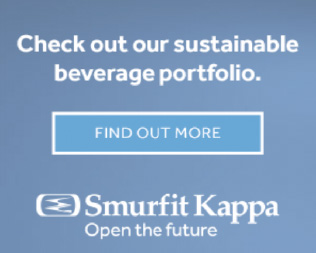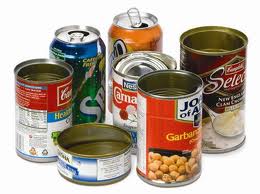While plastic packaging is grabbing market share globally, metal containers are on a solid upward trend in regional markets such as Africa and the Middle East, writes Debabrata Deb.
Over the five years from 2004, metal packaging grew at an annual average of 2.8% to make up 18% of packaging consumption by value in 2009. Meanwhile, though, plastic packaging surged –by 4.3% per year for flexible and 6.5% for rigid packaging – to take a 30% slice.
The trend has been propelled by rising demand for PET bottles in soft drinks and bottled water; substitution of metal, glass and sometimes paper and board; trends in meat, fish and poultry packaging; the popularity of ready-to-eat foods; convenience products such as for on-the-move consumption.
PET bottles already take nearly 60% of the soft drink, fruit juice and water bottle market. Plastic are also set to grab more of the beverages market as PET recycling attains economies of scale and new polymers and production processes enable down-weighting with increased shelf life. Meanwhile spouted pouches will also eat into metal containers’ market share.
Even so, studies show metal containers will maintain a steady growth of 2% and 3% globally. And a regional breakdown of market trends reveals wide variations, with both Africa and the Middle seeing metal container consumption rising at a two-digit pace.
Regional variations
In emerging markets, metal containers are also used in untypical ways. While food and beverage applications make up 95% of their applications globally, in emerging markets 25% of metal containers are for non-food uses.
These applications – such as paints, lacquers and sealants – are also seeing significantly higher growth, in line with expanding construction and housing sectors, especially in Africa and the Middle East.
Lifestyle enhancements and aspirational buying in the developing economies are also driving sales of metal containers for: energy drinks such as Red Bull; health care and nutraceutical products such as high nutrition, health and convalescence-driven brown and white powders, gastro relief tablets, pain relief sprays; low calorie products such as Diet Coke; high value snacks such as cashew nuts and special cookies; personal care ‘feel good’ and ‘freshness’ products such as aerosol containers for deodorants and fragrances; and home care products such as insecticide aerosol containers, freshness spray containers, and paint containers.
These trends are particularly apparent in the high growth Asian and Middle Eastern countries and some parts of the Central and South America. In the Middle East, a shift from imports towards local production in beverages helps drive demand.The drive to cut food waste could also propel the use of metal containers for processed food, giving long shelf lives. Lifecycle studies (LCAs) could open up policies to favour metal containers for selected food items in specific regions.
Metal container makers
Rexam, the world’s largest supplier of beverage cans, specialises in aluminium cans. With a supply chain that extends from bauxite to cans and easy open ends, Rexam is the leader in Europe (45%) and after its purchase of Latasa in South America, the largest supplier in that continent (68%) as well. The firm has now expanded into India – with steel and aluminium cans – as well as China and is increasing its capacity in the Middle East.
Rexam has introduced a re-sealable aluminium can for the JOLT Battery bottle. This bottle offers the inherent benefits of the aluminium can: guaranteed freshness, superior carbonation retention and shelf-life, quick chilling, easy distribution and excellent filling economics. Due to the unique re-sealability feature, consumers will be able to experience the freshness and energy boost (two hits of caffeine in every serving) of JOLT at their own pace.
The power gauge printed in thermo-chromic ink informs consumers about the state of chilling and how much of the exhilarating drink is left in the bottle. Ball Corporation, another major player in North America, specialises in soft drink and beer cans. The company has a growing presence in Europe but its major growth has been in China, where it holds a 22% market share plus another 13% from joint ventures.
Ball’s three-piece food cans are used for vegetables, fruit, meat, seafood, nutritional products, pet foods and other products. Crown bases much of its manufacturing in the US but derives 78% of its revenue elsewhere, mainly Europe. Lower cost manufacturing in the emerging economies is likely to challenge Crown, particularly in Europe, but the company has begun to reduce costs and explore emerging economies.
Amcor Beverage Aluminium Cans support a range of end uses from wine and spirits to beer and cider to alcoholic ready-to-drink (RTD) to carbonated soft drinks, fruit juices and nectars, milk and coffee, functional and energy drinks, tea and water. It is particularly strong in Australia and New Zealand but has a significant presence in North America.
Amcor takes an integrated approach to packaging, covering all major segments including glass bottles, printed cartons, flexible packaging, closures and CFCs. Siligan Holdings is North America’s largest manufacturer of metal food containers with 50% of the US market. Its major customers are Campbell Soup, Del Monte Foods, General Mills and Hormel Foods.
Rexam, Ball, Crown, Amcor, Siligan and Metal Container Corporation make up almost 30% of the global metal container market, valued at $31bn in 2013).
Manufacturing methods
More than 600 styles and sizes of cans are manufactured globally. Types of cans include two-piece aluminium beverage cans, round composite cans, round sanitary open top cans, aerosol cans, drawn tins, friction plug type paint cans, key opening cans, screw top cans, plastic top cans (including cone top and other configurations), oblong cans (easy opening, edible oil type, hinged cover, household machine oil, key opening, spice type, solvent style) and square cans (five gallons or smaller).
Three-piece can bodies are made from flat sheets cut from coils of tin-plated or tin-free steel, depending on the end use. The tin plating is applied to prevent rust. Tin-free steel is electro-coated with a layer of metallic chromium covered by a layer of chromium oxide. Before the bodies are formed, coatings are usually applied to the interior and exterior surfaces with a roller onto the flat sheet.
Two-piece cans are made by forming a cup-shaped container with one piece of aluminum or steel and attaching an end to it. Two-piece cans are manufactured either by the draw-redraw process or the draw-and-iron process. After the fabrication process, various coatings are applied and cured.
Under the draw-and-iron process for aluminum beverage cans and one-piece cans, the metal coil is continuously fed into a cupper that stamps shallow metal cups from the coil. Each cup is stamped, placed on a cylinder, and forced through a series of rings of decreasing annular space, which further draw out the wall of the can and iron out folds in the metal.
One-piece cans are subjected to more severe necking than beverage cans because the valve is placed directly on the can – there is no end piece. The two-piece draw-and-iron steel food can manufacturing process is similar to the aluminum beverage can process except that food cans are typically decorated with paper labels so printing and over-varnish steps are unnecessary. Instead, a ‘wash coat’ is applied to protect the can from corrosion. The wash coat is applied after the washing process, but before drying.
In the draw-redraw process, as in the draw-and-iron process, aluminum or steel coil is continuously fed into a cupper that stamps shallow metal cups from the coil. Shallow cans may be stamped only once, whereas deeper cans may require one or two additional stamps.
Aluminum beverage can ends are made exclusively from pre-coated coil. Beverage can ends are stamped from coils in a reciprocating press.
After stamping, the ends are scored in an oval pattern and a tab is attached to form an ‘easy open’ end. These steps are performed after the end piece has been coated and therefore damage the coating. Repair coatings are applied after these steps to restore the integrity of the coatings.
New types of lacquer with ultra-low gsm and new application systems with electron beam curing could now be applied in metal containers.
The metal container industry has yet to use electron beam curing in the manufacture of metal containers but this technology would allow very low coating weights of lacquers, over-varnishes and spray coatings with full protection of the base metal/printed surface. VOCs would be reduced, machine speeds increased and overall energy consumption reduced in the process.
The metal container industry should therefore start working with universities, suppliers and technology consultants in this direction. The industry also needs to substantially upgrade the efficacy of the coating processes and work with international coating experts to achieve the goal of ultra-low gsm, uniform, pinhole-free application.
Market forecasts
The global metal container market is forecast to hit $102.1bn this year and $120bn by 2020. The main end use will continue to be beverage cans (70%), followed by food cans (20%).
But non-food items are predicted to make up nearly 30% of the market in the developing economies by 2020. Beverage cans are being optimised for weight, cost, handling, filling and recycling. About 70% will be aluminium containers and 30% steel containers.
Through their ability to withstand loss of cold chain and to convey the premiumness of a brand, beverage cans are set to maintain their attraction even in developing economies.
But the biggest opportunity for metal containers may come from their potential for 100% recycling – an aspect the industry must work on, along with local governments, communities, universities and the recyclers.
Metal containers can be easily compacted and recycled. In fact, about 60% of metal containers are already being recycled. Aluminium cans are recycled more easily than steel cans due to the greater value realised by those engaged in the recycling process.
A recycled aluminium can has a drastically lower energy than a virgin can. Although aluminium cans are more expensive than steel cans in virgin form, they can become cheaper through recycling due to lower handling and recycling costs.
Conclusion
The metal container industry has a bright future if: a) the LCA approach is adopted; b) container manufacturing technologies are upgraded for down-gauging, down-sizing, higher productivity, lower wastage, reduced energy consumption; c) consumer aspirations, communication, safety and convenience are addressed fully; d) the industry ensures ultra low coating weights and ultra-low levels of VOCs from the inks, lacquers and varnishes.




